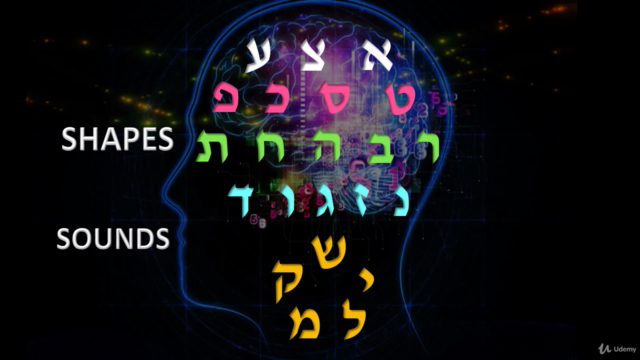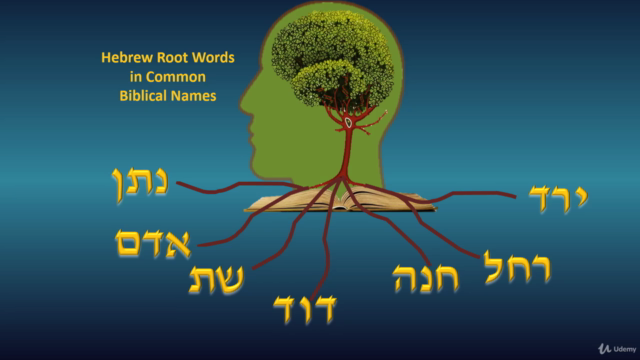Hebrew Root Words in Common Biblical Names
Start to read Hebrew in the bible through biblical names you know

What you will learn
Be able to read Hebrew from right to left through special training exercises.
Learn how to decode the Hebrew alphabet with Biblical names that you know.
Know Hebrew root words that can be used to form other words.
Recognize over 30 vocabulary words using the Alphabetic Priniciple in the Hebrew Morph.
Blend sounds of the Hebrew letters to form words.
Begin to learn the systematic relationships of Hebrew letters in making words.
Gain a better understanding of Biblical Hebrew grammar through analyzing Biblical names.
Be more familiar with Hebrew scripture through an English version that reflects the Hebrew formation.
Be prepared for our major course in UDEMY "Learn to Read Hebrew in the Bible."
Why take this course?
This course is the second in a series in E-Vreet that helps you learn how to read and prepares you for traditional Hebrew courses. In this course, you take the step from recognizing Hebrew letters to seeing how they form words through the concept of the Hebrew Morph Root. This is more of an exercise course to map your brain with the Hebrew letters.
Start to Read the Hebrew Bible Using Names You Know
- Recognize Hebrew Letters and some simple words
- Learn about vowels when an English word is morphed into Hebrew.
- Learn Hebrew names help you learn vocabulary.
- Understand how the more challenging Hebrew letters work.
- Learn to recognize these names and words they mean in Hebrew scriptures
- Create some simple sentences in Hebrew.
- Find your way around a Hebrew Bible verse and get new insights.
Many names you know, perhaps even your name, originate from a Hebrew name. These names hold a secret on how we can learn Hebrew. E-Vreet has chosen 12 names that have Hebrew origin and will use these names to reveal this secret to you by means of the Hebrew Morph.
How does the Hebrew Morph work?
By morphing English names that you know into Hebrew, you can start to see how Hebrew letters work to spell out a name that you already know. You'll experience the process of transforming an English name into Hebrew. The Hebrew Morph uncovers just how Hebrew is different than English in a step by step process that slowly changes before your eyes.
Exercises to help you learn new words in Hebrew
1. FIND THE NAME: The Hebrew Morph is just part of the process. Once the name has been morphed into Hebrew letters, your mission is to find that name in three Hebrew scriptures. You watched the word morph into Hebrew which made a distinct impression, so the letters are in your short-term memory. Through the activity of searching for the word in the verse, the Hebrew word can move into your long-term memory.
2. FIND THE WORD: Then you will learn what Hebrew words are hidden in the name. Knowing words are the first steps in learning a language. They are the first meaningful units. When something has meaning, it is easier to remember. Now you will look for these words in selected scripture verses. The scriptures will also help you see what these words mean in context.
3. USE THE WORD: Towards the end of the course, you will put some of the words together to make simple sentences. You will also learn about Hebrew words that are always attached to Hebrew root words.
4. QUIZZES: There are quizzes after every unit to reinforce what you have learned and also applied what you have learned to new words. There is also a Final Review and Final Exam.
Structure of the Course:
Unit 1: Simple Hebrew Morph
Unit 2: Morphing Names that have sounds not in English
Unit 3: Morphing Names that mean whole sentences or phrases in
Each unit has an introductory video which will review what you need to know from the Meet the Hebrew Alphabet course. It will also give you an overview on the special features of the unit.
Structure of the Video Lessons
1. The introduction, explaining what to look for in the Hebrew Morph and reviewing letters you need to know from the previous course.
2. The Hebrew Morph
3. The Scripture Exercises
4. The Recap--reviewing what you have learned, giving insights to the words and scripture.
Structure of the PDF files
The PDF files model the video lessons. It is important to review the PDF files. They are designed in such a way that you see the scripture without the answer on the page, and have to turn the page to see the answer. This is another way you can test yourself.
Why is the music so important?
The carefully selected music relaxes yet stimulates your brain to learn. As the Hebrew letters form words, the language center of the brain is activated to recognize groups of Hebrew letters as meaningful units.
Why does the English translation of the verses have so many hyphens?
By the second unit, the Bible verses uses in this course are translated in English that reflects the Hebrew words. For instance, you will see how Hebrew doesn't need as many words as English. The verses are carefully arranged in order that you can learn even more words than are on the target list. You will start to see the same words over and over again. This is a natural way to learn a language. Since you are acquainted with the verses, you may be able to learn extra words. It all depends on you!
Will this course help me in my regular bible study and prayer?
Studying Hebrew helps unlock deeper meanings in many verses of the Bible. By digging into the Hebrew, this course helps you find treasures and new insights simply by learning words from names you already know. This will help you will your own study, meditation, and teaching others.
Will I be able to put sentences together in Hebrew?
By the third unit, you will learn how to make your own sentences in Hebrew. Unlike many traditional courses, E-Vreet shows you how Biblical Hebrew becomes a means of communication for you. When the brain uses a language as a means of communication, it remembers words and sentences much easily. You can start to use the words you learn in your prayers.
This course will inspire you to want to learn more Biblical Hebrew. It will take the fear out of using a foreign alphabet and replace it with a love for the language and what it says. You will be able to open a Hebrew Bible and actually finds words that you know. It's a beginning of a wonderful adventure.
Screenshots




Our review
Charts
Price

Rating

Enrollment distribution
